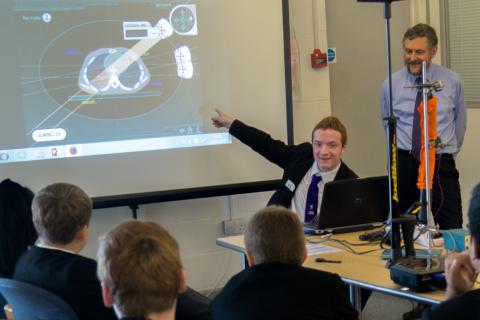Computational Radiotherapy at Physics at Work 2018
Computational Radiotherapy
University of Cambridge and Addenbrooke's Hospital
What will students see at your exhibit?
Students will see how computing, engineering, mathematics, medicine and physics combine to improve treatment of cancer.
An average person is made up of more than ten million million cells, which are continually being replaced. Cancer starts when the processes controlling cell replacement go wrong, and faulty cells are produced in large numbers. These faulty cells can build up in the blood or may form lumps, known as tumours. Radiotherapy, the physics approach to treatment, aims to destroy tumour cells by firing large amounts of energy at them. This energy usually comes from X-rays, but can also come from sub-atomic particles.
Students will learn about different types of imaging used in radiotherapy, they will have a chance to try their hand at treatment planning, and they will be able to examine parts from a machine for producing X-rays.
What physics is used?
The physics used deals with: X-rays; atomic structure; electric and magnetic fields; transmission and absoprtion of electromagnetic radiation.
Why is it useful?
Radiotherapy, by itself or in combination with surgery and chemotherapy, is a successful treatment for many cases of cancer. The challenge is to deliver enough energy to destroy a tumour, while avoiding damage to nearby healthy body parts. Work in progress aims to improve monitoring of where energy is being absorbed, over a course of treatment that involves up to forty sessions over eight weeks. This can allow the design of better treatment strategies, with higher cure rates and fewer side effects.

Further Reading
Computational Radiotherapy Website
Missions in medical physics: http://insidestory.iop.org/insidestory_flash1.html
